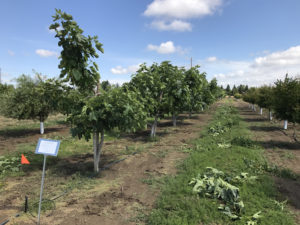For years, fig growers have fought broadleaf weeds on orchard floors with herbicides such as glyphosate. As more weed species developed resistance to glyphosate, fig growers approached the IR-4 Project with a request to find new tools to ensure a healthy, weed-free crop for consumers.
Fig growers need a clean orchard floor to harvest a good quality fig. Unfortunately, broadleaf weeds such as hairy fleabane and horseweed (also referred to as marestail) are becoming resistant to tools used historically by growers to control weeds.
“Figs are a relatively small acreage crop with around 8,000 acres in California and are not a big market for registration of new products,” said Brad Hanson, cooperative extension specialist with the University of California, Davis. “Growers typically rely on only a handful of herbicides in the fight against weeds each year.”
On behalf of fig growers, California Figs submitted a request to the IR-4 Project to identify a new solution for controlling broadleaf weeds in fig orchards. The request was selected as a priority for funding at the 2014 Food Use Workshop.
Researchers conducted “shotgun screening” trials from 2015 through 2018 where several herbicides were studied at multiple commercial orchards in California. Trials focused on weed control and safety of the fig crop after application. Saflufenacil, marketed as Treevix® Powered by Kixor® Herbicide and manufactured by BASF, was among the herbicides included in the trials.
“With specialty crops like figs that are not widely grown, it’s really important to initially focus on crop safety. I always like to have a super boring crop safety trial because that means there was no injury to the crop,” said Hanson. “Every time I have no data to talk about in a crop safety trial, that’s a good thing.”
Treevix was identified as an effective tool for controlling key broadleaf weeds in figs with good crop safety and a relatively low environmental impact. The herbicide is applied at one ounce per acre, similar to a pad of butter spread across a football field, according to Hanson. The IR-4 Project conducted additional research to ensure there were no issues with herbicide residue on the crop after application.
The IR-4 Project submitted a petition and required data to the U.S. Environmental Protection Agency (EPA)

in May of 2019 for the approval of Treevix to be used on fig orchards. The EPA approved the use in September of 2020. Crop safety data was provided to the California Department of Pesticide Regulation so the product’s label could be expanded in California. The expansion was completed in time for the 2021 fig growing season.
Many fig growers already have access to Treevix in the fight against broadleaf weeds on other crops, such as almonds. Now, they have one product that they can use across multiple crops to manage their orchard floor.
“This has been a really good partnership with the fig industry to identify their needs,” said Hanson. “BASF has been a great partner in this effort. This is exactly what the IR-4 Project is designed to do; help specialty crop growers find solutions for their pest management problems.”
About the IR-4 Project
The mission of the IR-4 Project is to facilitate regulatory approval of sustainable pest management technologies for specialty crops and specialty uses to promote public well-being. By working directly with local crop growers across the country, IR-4 conducts research and develops data necessary for the registration of pest management tools, ensuring that they are safe for use. To learn more, visit our website.
